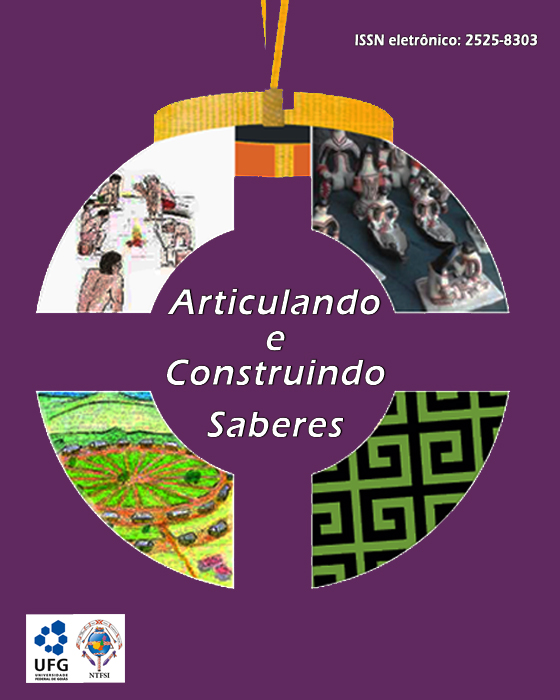Why document and describe languages? The importance of these studies in the policy of revitalization and strengthening of Brazilian indigenous languages
DOI:
https://doi.org/10.5216/racs.v6.67284Keywords:
Documentation & Description. Revitalization. Indigenous Languages.Abstract
Studies of documentation and linguistic description are two important steps in the strengthening, maintenance, preservation and revitalization of languages, especially those that are under endangered, as is the case of many Brazilian indigenous languages. The task of recording a language involves two basic activities that are related but have different objectives: documentation and linguistic description. This paper presents some reflections on the importance of documentation and description studies for strengthening and revitalizing endangered languages. Besides that, examples of revitalization actions for four Brazilian languages (Kaingang, Nhandewa-Guarani, Xokleng/Laklãnõ and Krenak) are presented in order to discuss and promote the valorization linguistic and cultural of these languages, in addition to reaffirming the importance of these studies for scientific knowledge and linguistic phenomena of Brazilian indigenous languages.
Downloads
References
AUSTIN, Peter. Current Issues in languages documentation. Language Documentation and Descripition, Londres: SOS, v. 7, p.12-33, 2010.
AUSTIN, Peter; SALLABANK, Julia. Language endangerment. Cambridge University Press, New York, 2011, 581 p.
CRYSTAL, David. A revolução da linguagem. Tradução Ricardo Quintana. Rio de Janeiro: Jorge Zahar Editores, 2005.
D’ANGELIS, Wilmar da Rocha. Kaingáng: questões de língua e identidade. (1996). Liames: Línguas Indígenas Americanas, v. 2, Campinas: IEL-Unicamp, p. 105-128, 2002.
______. Quando os falantes nativos são os professores, os professores são pesquisadores, e os linguistas são parceiros. Signo y Seña, v. 29, Buenos Aires: Facultad de Filosofia y Letras (UBA), p. 63-77, 2016.
______. Línguas Indígenas no Brasil: quantas eram? Quantas são? Quantas serão? Revitalização de Línguas Indígenas: como fazemos. Campinas-SP: Curt Nimuendajú: Kamauri, 2019, p.13-27.
DRUDE, Sebastian. Documentação Linguística: O Formato de Anotações de Textos. Estudos Linguísticos, XXXV, p.27-51, 2006.
FERREIRA DA COSTA, Francisco Vanderlei. Revitalização e ensino de língua indígena: interação entre sociedade e gramática. Tese (Doutorado em Ciências e Letras) – UNESP, Araraquara (SP), 2013.
FRANCHETTO, Bruna; MAIA, Marcus. Educação e Revitalização linguísticas. (2017). Revista LinguíStica: Revista do Programa de Pós-Graduação em Linguística da Universidade Federal do Rio de Janeiro, v. 13, Rio de Janeiro: Universidade Federal do Rio de Janeiro, p. 1-10.
GALUCIO, Ana Vilacy; MOORE, Denny; VOORT, van der Hien. O patrimônio linguístico do Brasil: novas perspectivas e abordagens no planejamento e gestão de uma política da diversidade linguística. Revista patrimônio histórico e artístico nacional, IPHAN, n. 38, 2018, p.195-218.
HALL Jr., Robert A. The life-cycle of pidgin languages. Lingua, 78, 1962, p. 152-155.
HIMMELMANN, Nikolaus P. Documentary and descriptive linguistics. Linguistics. 1998, 36:161-95.
______. Language Documentation: What is it and what is it good for? In: GIPPERT, Jin; HIMMELMAN, Nikolaus; MOSEL, Ulrike (Org.). Essentials of Languages Documentation. Berlim: Mouton de Gruyter, 2006, 437 p.
HORST, Cristiane; KRUG, Marcelo Jacó; FORNARA, Ana Elizabeth. Estratégias de manutenção e revitalização linguística no oeste catarinense. Organon: Revista do Instituto de Letras da UFGRS, v. 32, Porto Alegre: Universidade Federal do Rio Grande do Sul, p. 1-16, 2017.
MOORE, Denny, GALUCIO, Ana Vilacy, GABAS JUNIOR, N. Desafio de documentar e preservar línguas. Scientific American Brasil. v.3, p. 36 - 43, 2008. Edição Especial.
MOORE, Denny; GALUCIO, Ana Vilacy. Perspectives for the documentation of indigenous language in Brazil. In: Gabriela Pérez Báez; Chris Rogers; Jorge Emilio Rosés Labrada (Org.). Language Documentation and Revitalization in Latin American Contexts. 1 ed. Berlin: De Gruyter, v. 295, p. 29-58, 2016.
MENESES, Guilherme Pinho. Saberes em jogo: a criação do videogame Huni Kuin: Yube Baitana. GIS: Gesto, Imagem e Som, v. 2, São Paulo: Universidade Estadual de São Paulo, p. 83-110, 2017.
MOSELEY, Christopher (ed.). Atlas of the World’s Languages in Danger, 3rd edn. Paris, 2010. UNESCO Publishing. Online version: http://www.unesco.org/culture/en/endangeredlanguages/atlas.
RODRIGUES, Aryon. Línguas Indígenas: para o conhecimento das línguas indígenas. São Paulo: Loyola, 1986.
______. Línguas indígenas: 500 anos de descobertas e perdas. D.E.L.T.A., v. 9, n.1, p. 83-103, 1993.
______. Sobre as Línguas Indígenas e sua pesquisa no Brasil. Linguas do Brasil/Artigos, p.35-38, 2005.
RODRIGUES, Ulisdete Rodrigues de Souza. Elementos para a compreensão de Línguas Crioulas e Pidgins: conceitos e hipóteses. Abe África: revista da associação brasileira de estudos africanos, v.02, n.02, p. 43 – 59, 2019.
SCHULTZE-BERNDT, Eva. Language Documentation. Syntax-theory and analysis. An international handbook. ed. / Tibor Kiss; Artemis Alexiadou, v. 3, Berlin: de Gruyter, Walter GmbH & Co, 2015. p. 2063-2094.
SEKI, Lucy. Línguas Indígenas do Brasil no Limiar do século XXI. Impulso, Piracicaba, v. 12, n. 27, p. 157-170, 2000.
WOODBURY, A. C. Language Documentation. In: AUSTIN, P. K.; SALLABANK, J. (Org.). Language documentation and archiving. New York: Cambridge University Press, 2011. p. 159-186. DOI https://doi.org/10.1017/cbo9780511975981.009.
Downloads
Published
How to Cite
Issue
Section
License
Copyright (c) 2021 Articulando e Construindo Saberes

This work is licensed under a Creative Commons Attribution 4.0 International License.
Authors authorize Articulando e Construindo Saberes to publish an article, if accepted, signing their contribution as original and not submitted to another publisher for publication. If accepted and published, Articulando e Construindo Saberes articles have a Creative Comons CC-BY license.




